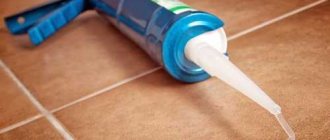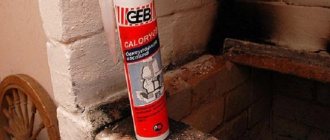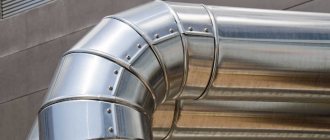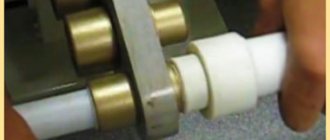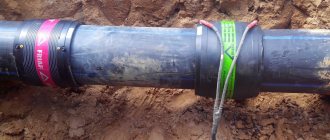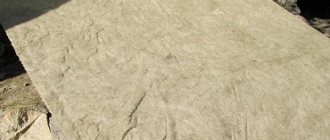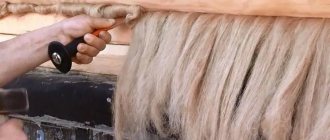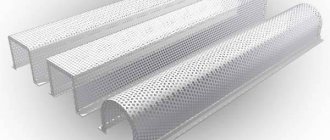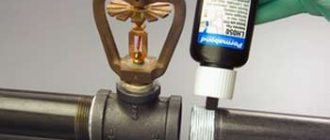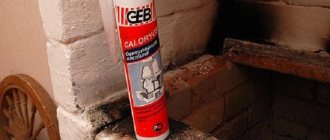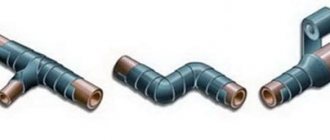The results of a good pipe sealant are invisible to most people. Now, if he was bad, unsuitable, or did not exist at all, this will immediately become clear to everyone. This will be indicated by the liquid that will seep through the joints of the surrounding pipes and cause a lot of trouble.
The risk of leakage always exists, even with new and fully functional joints, so the choice of this important material should be taken with great responsibility. Having previously studied the following: what it is, where it is used, what additional nuances it carries, which one is better to choose.
In this article, the editors of the YaNashla website answered these and other questions, and also prepared for you a rating of the best pipe sealants for 2021.
Scope of application
Most of the sealants in any home are used in plumbing and heating systems. It is necessary to remember that water is supplied inside the pipes and heating radiators under pressure, therefore, at any, even the smallest opportunity, it tends to break out. This leads to a simple and understandable conclusion - sealant is needed wherever there is water and pipes. In any apartment, this is, first of all, a bathroom, toilet and kitchen.
Types of sealants and scope of application
Despite the simple and understandable function, there are a large number of types of sealants, they can be divided by application and composition.
- For heating systems
The heating system uses different materials: cast iron, aluminum, steel, as well as various alloys, what they have in common is that there is hot water under pressure inside, and accordingly, heat-resistant sealants are needed.
- For sewage systems
Sewerage is not exposed to prolonged exposure to high temperatures; here another “enemy” is moisture and dampness inside and outside, so you should not use products that can rot; the best option would be to use sanitary and polyurethane sealants.
- For water supply systems
The main requirements here are reliability and harmlessness. Waterproof, neutral compounds without dyes are used.
Naturally, in addition to sealing pipes, they are also used for other work:
- when installing the roof;
- to give strength to greenhouses;
- for tile joints;
- when attaching cladding and mirrors.
Most sealants have their purpose indicated on the packaging. In this review, we are interested in pipe ones.
Compound
- Linen thread
The easiest and cheapest way to fix a leak is to wrap the thread with linen thread. This is a natural product that has recently been increasingly losing its popularity. When wet, it swells and prevents further leakage. However, along with the obvious advantages, it has one significant drawback - it quickly becomes unusable. It rots, collapses and requires additional winding. Modern flax, although it is treated with a chemical composition that increases shelf life, still requires attention faster than others.
- Polymer tape
Better known as FUM tape, it is made from a material that does not rot and does not lose its properties for a long time. This is one of the most common sealants, however, it is not recommended to use it for large diameter pipes, as well as in cases where there is a possibility of vibration and temperature changes.
- Plumbing thread
It is a synthetic thread - it is not subject to rotting and is quite durable. It can survive dismantling and protect the metal from rust, but it has a high price, so it is less common among specialists.
- Liquid sealants
They are used both in combination with tape and separately. They provide additional protection, but if you know that there is high fluid pressure in the system, it is better not to use them without thread or tape. Are divided into:
- Anaerobic compounds: The substance solidifies in a vacuum, but remains fluid in air. Adheses well to various metals and plastics, and is chemically neutral to liquids. Recently, it has been widely used in plumbing work.
- Silicone compounds: The most common and versatile product. It has all the necessary properties - it tolerates high temperatures well, penetrates into various cracks and crevices, is elastic, harmless.
Sealant application technology
As noted above, the process of sealing the drain line largely depends on the type of pipes. Seals have a number of restrictions on the method of application and compatibility with materials, so this aspect deserves special attention.
Sealing cast iron pipes
Different means are applicable for these systems. Professional plumbers often use PVC tape as it allows for good results while also helping to maintain the integrity of the pipes themselves. It can be used to process other elements of a cast iron pipeline:
- insets;
- turns;
- bends;
- stubs.
After cleaning and drying the surface of the pipes, you need to apply the tape stretched and wind it along the outer diameter of the joint, avoiding unevenness. It is necessary to wind it overlapping, gradually. For a tight connection, several layers of sealing should be made. If we are talking about external sewer systems, then the tape should be covered with a protective layer, protecting it from UV radiation.
Sealing the junction of cast iron and plastic pipes
In this case, it is necessary to clean and degrease the bell using special means. The internal cavity and the outer part of the smaller diameter pipe are thoroughly lubricated with liquid sealant. Next, the structure is connected and securely fixed until complete hardening.
If you cannot connect the pipes in a standard way, then you need to use a cast iron/plastic adapter. First, it should be prepared for this procedure by cleaning the surface and applying a small amount of sealant to it. This will help create a superior seal to the sewer drain.
What to look for when choosing?
- When heading to the store, you should already have an idea of what kind of work you need a sealing agent for. This is the first thing the seller will ask you.
- In addition, try to study in detail the instructions (it should be on the packaging) of what you will be offered.
- Determine whether the composition is for interior or exterior use.
- There must be an indication of the type of work (plumbing, roofing, etc.).
- Properties of the sealant - whether it has heat resistance or elasticity.
- Check if it suits your color.
- If there is an indication on the packaging that it belongs to the professional group, keep in mind that it is more difficult to work with, and additional knowledge of its features is required.
- Is it possible to use it in a pistol?
Types and types
Sealants on the market are presented in a wide variety of prices and types.
However, this does not mean that the use of one material is possible for cast iron and metal-plastic at the same time. Typically, there are different types of sealing compounds that are used for exterior and interior applications.
Sealants are a material that is resistant to mechanical stress at different pressures and temperatures. They come in the form of tapes, threads, liquid mixture or paste consistency. The main task of all materials is to resist the leakage of liquids from pipes.
Butyl rubber sealants are high-value self-adhesive materials that are suitable for many surfaces. Sealing tape is the only material that can be used both indoors and outdoors.
Linen
This type of plumbing seal connects individual elements of the pipeline with a threaded connection. Disadvantage: swelling with constant contact with water. As a result, the pipeline may rupture at the connection point.
Over time, flax fibers decompose when exposed to moisture, and the quality of the joint decreases.
Also another drawback is the formation of rust at the joint, which leads to corrosion of the metal. Do not use dry flax in systems where liquid is transported under high pressure.
More often, flax is used with paint treatment: first, the pipeline is wrapped with linen tapes, and then painted.
This solution is more practical, but it also has a drawback - the flax is not completely saturated with paint, and rotting begins over time.
FUM sealing tape
A fluoroplastic sealant is a polymer tape in the form of a thin strip that can withstand temperatures up to +300 degrees, and also works perfectly even in an unfavorable environment with chemical elements. The only drawback is that when the tape vibrates, it causes depressurization.
Plumbing thread
The sealant, in the form of thin fibrous threads impregnated with an antiseptic, does an excellent job of holding the pressure load. Also, the installation of utilities with the thread allows for the possibility of reversing the elements by 180˚.
Anaerobic
When applied, they dry without access to air, while the volume does not change. This helps protect the pipeline from leaks and corrosion. Advantages:
- Good adhesion allows for a tight connection between plastic and metal-plastic pipes.
- Use not only in plumbing systems, but also in hazardous environments.
- Inert to the negative effects of chemical elements.
- Used in pressure and non-pressure water supply.
- Excess is removed with a napkin.
Application of such a gel is impossible in rooms with air temperatures below room temperature. Also, before applying the composition, the surface must be degreased.
Jute and hemp ropes
Ropes and strings are used as a decorative component of wood, and are not used as pipeline sealant. Popular materials for decorating joints are jute and manila ropes. Ropes made of flax and hemp are also used. The ropes fix the insulation in one position, preventing it from swelling.
Epoxy resin
Resins are liquid sealants that are used for exterior use and in damp environments.
The composition is often used together with the cement mortar of the external pipeline: first, it is sealed with a concrete composition and, after drying, the pipe is coated with epoxy resin. The material is highly toxic.
For preparation, resin and hardener are used. However, it is worth checking the proportions first, since with a larger amount of hardener the composition may boil.
Technical sulfur
Polysulfide oligomers have been used as a sealing mixture for about 70 years. When cured, based on the composition, sealants are produced that are used in building structures and industry. The area of use depends on many factors, in particular on the adhesion between vulcanizates and aluminum, steel, brass, and wood. In order to ensure tightness, adhesive additives are added to the adhesive sublayers.
Cement
A mixture of cement and concrete is the simplest, but least effective method of sealing a pipeline, which is most often used in outdoor work.
Over time, such material dries out and depressurization occurs. A widely used plumbing cement is Portland cement. Includes:
- clinker;
- gypsum;
- calcium silicates.
The dry mixture is diluted with water to the desired consistency. The solution hardens quickly and is used in low temperature conditions (frost).
Bitumen mastics
Plastic and liquid material is used in waterproofing pipes, tanks and wooden supports. The composition includes mineral bases and binders, asbestos dust and powdered powders to improve resistance to low and high temperatures. Main technical characteristics and advantages:
- 0.2-0.5 MPa (kgf/cm2) strength (conditional);
- concrete adhesion – 0.3-0.4 MPa (kgf/cm2);
- water absorption no more than 1%;
- elasticity after drying;
- resistance to mechanical damage;
- elongation at break up to 300%;
- viscosity 15-30 seconds;
- begins to soften at temperatures above 130°C.
Silicone and acrylic
They are often used to seal the joints of bathtubs, toilets, and sinks. They have a whitish or translucent color; among the disadvantages is low resistance to permanent mechanical damage. Also, over time (in particular silicone sealant), the material lags behind the base, which allows liquid to leak.
Thiokol sealants
Polysulfide compounds are the most durable. They are used for different pipes. As a rule, they consist of several components: a base, a hardening paste and additives to accelerate vulcanization. The mixture is prepared immediately before application, and the resulting composition is used within 2 hours.
Advantages:
- elasticity;
- resistance to gasoline, kerosene and oils;
- resistance to precipitation;
- not exposed to UV rays;
- used in a wide temperature range - from -50 to +1300 degrees;
- high adhesion to reinforced concrete, metal;
- long service life.
Minuses:
- high price;
- toxicity;
- All work must be carried out immediately, since the composition hardens quickly, but hardens in several hours.
List of Best Pipe Sealants for 2021
“Repair 100%” white, all-season
The sealant contains silicone rubber, which increases adhesion to various materials, and acetic acid, thanks to which it can withstand temperature changes.
Average price – 150 rubles.
Characteristics:
| Volume/weight | 260 ml. / 350 gr. |
| Application temperature | +5°С – +40°С |
| Type | sanitary silicone sealant |
| Operating temperature | –40°С — +100°С |
| Application area | for interior use, sanitary, for pipes |
| Package | cartridge |
| Peculiarities | heat resistant, anti-fungal, elastic, waterproof |
| Processing material | ceramics, glass, aluminum |
Budget brand. Presented with a small assortment of the most popular household sealants on the market at the lowest possible price. It stands out among competitors not only in price, but also in its bright packaging design. Visible in any hardware store. Product quality is acceptable for economy class goods.
“Repair 100%” white, all-season
Advantages:
- affordable price;
- absence of foreign odors;
- copes well with small cracks;
- dries quickly.
Flaws:
- not identified for this price segment.
Kim Tec Silicon, clear, all-season
A one-component sealant based on silicone. In a humid environment it hardens and becomes rubber-like. Suitable for working in a vertical position, sets quickly.
Average price – 250 rubles.
Characteristics:
| Volume/weight | 310 ml. / 350 gr. |
| Application temperature | +5°С – +40°С |
| Skin formation time | up to 10 minutes |
| Storage rules | store vertically, with the valve facing up, in a cool, dry place at an ambient temperature of at least +5°C |
| Type | silicone sealant |
| Application area | for interior use, sanitary, for pipes |
| Package | cartridge |
| Peculiarities | UV resistant, heat resistant, anti-fungal |
| Processing material | wood, stone, concrete, ceramics, ceramic tiles, PVC and other plastics, glass, metals |
German brand of building materials. It is characterized by high European quality, responsible attitude towards customers and constant product development.
Kim Tec Silicon, clear, all-season
Advantages:
- can be used as glue;
- high quality;
- wide range of applications.
Flaws:
- has a pungent odor;
- doesn't wash well.
Ultima 80, white
"Ultima 80" - designed for use in rooms with high humidity.
Average price – 200 rubles.
Characteristics:
| Volume/weight | 80 ml. / 120 gr. |
| Application temperature | +5°С – +40°С |
| Operating temperature | –40°С — +120°С |
| Drying time | 10 – 25 minutes |
| Application area | for interior use, sanitary, for pipes |
| Package | tube |
| Peculiarities | UV resistant, heat resistant, anti-fungal, elastic, moisture resistant |
| The basis | Silicone |
| Processing material | wood, porcelain, plastic, glass, ceramics |
A brand from Europe, designed for both repair specialists and ordinary users. Contains a large line of high quality products at reasonable prices. Production is located in several countries and has a progressive control system for final products.
Ultima 80, white
Advantages:
- European quality at an affordable price;
- Excellent for gluing glass structures.
Flaws:
- Strong smell;
- inferior to competitors in smaller volume.
Penosil All Purpose Silicon Sealant, colorless, multi-purpose
Can be used with almost any type of building materials, with the exception of vinyl and bitumen. It does not deteriorate under sunlight, is resistant to detergents and temperature changes.
Average price – 425 rubles.
Characteristics:
| Type | sealant |
| Application area | for exterior work, for interior work, for roofing, for pipes, for windows |
| Processing material | metal, wood, glass, plastic, ceramics |
| Volume | 310 ml |
| Type of packaging | cartridge |
| Peculiarities | UV-resistant, frost-resistant |
| Color | white, colorless |
| Type of silicone sealant | neutral |
| Operating temperature | -40°C — +150°C |
Well-known international brand of construction chemicals. It has a wide range of products used in all areas of construction and repair. Many years of experience, compliance with international safety requirements and the desire for innovation allow the company to produce one of the best products in the world.
Penosil All Purpose Silicon Sealant, colorless, multi-purpose
Advantages:
- versatility;
- convenient universal packaging;
- contains a fungicide that is resistant to mold;
- excellent adhesion to most materials.
Flaws:
- pungent odor of acetic acid.
Tytan Euro-Line, white, sanitary
Sanitary silicone sealant, thanks to its special composition, prevents the formation of mold and mildew. Easy to use. Retains its properties for a long time.
Average price – 200 rubles.
Characteristics:
| Volume/Weight | 290 ml. / 350 gr. |
| Application temperature | +5°С – +40°С |
| Seasonality | all-season |
| Compound | silicone polymer with acid curing system |
| Skin formation time | from 15 to 25 minutes |
| Heat resistance | -40°C — +100°C |
| Application area | for interior use, sanitary, for pipes |
| Package | cartridge |
| Peculiarities | heat resistant, anti-fungal, waterproof |
| The basis | silicone |
| Processing material | ceramics, glass, metals, brick, aluminum, PVC |
Famous Polish brand Selena. The product line includes a wide range of products in various areas of construction and repair. The company's extensive experience in production and close cooperation with professional consumers allows us to achieve the best properties of the product.
Tytan Euro-Line, white, sanitary
Advantages:
- reliable and high-quality product;
- Ease of use;
- Suitable for rooms with high humidity.
Flaws:
- strong unpleasant odor;
- high price.
REMONTIX, universal
The product is made on a silicone acid base. Resistant to sunlight and humidity. Ideal for sealing joints and seams of ceramic, wood and plastic materials.
Average price – 220 rubles.
Characteristics:
| Application area | for exterior use, for interior use, for pipes, for windows |
| Processing material | metal, wood, glass, plastic, ceramics |
| Volume | 310 ml. |
| Type of packaging | cartridge |
| Peculiarities | UV-resistant, heat-resistant, frost-resistant |
| Drying time | 15 minutes |
| Method of release from the cylinder | gun |
| Operating temperature | -40°C — +100°C |
The REMONTIX brand is relatively young. The entire product line is the fruit of the developments of modern technologists and engineers. In addition to various sealants, the range also includes polyurethane foam, adhesive tapes and seals.
REMONTIX, universal
Advantages:
- lays down in an even layer;
- good for bathrooms;
- price-quality ratio.
Flaws:
- unpleasant odor;
- no cap.
STAYER Master, neutral
Sealant for wide application, resistant to environmental influences. Has no smell. Has good adhesion to various building materials. Can be used with metals and concrete.
Average price – 250 rubles.
Characteristics:
| Application area | for exterior use, for interior use, for pipes, for windows |
| Processing material | metal, wood, glass, plastic, ceramics |
| Volume | 260 ml. |
| Type of packaging | cartridge |
| Peculiarities | UV resistant |
| operating temperature | -40°C — +100°C |
| minimum application temperature | +5°С |
Brand of the German company KRAFTOOL. The main specialization of the company is construction tools and equipment for the home. Thanks to many years of experience in construction, the company easily began working in the construction chemicals segment. A well-known name, wide range and quality allow us to compete in the Russian and international markets.
STAYER Master, neutral
Advantages:
- hardens well and quickly;
- does not shrink;
- has no pungent odor;
- prevents the spread of mold.
Flaws:
- not identified.
Why is sewer pipe sealing necessary?
Sealing the sewer systems of a house performs the following tasks:
- prevents the leakage of wastewater and the penetration of unpleasant odors from the sewer into residential premises;
- protects the floors of the house from the corrosive effects of wastewater;
- prevents flooding and destruction of foundations, basements, basements and other underground structures.
Sealing the external sewer allows you to prevent groundwater and rain from entering the common pipeline.
If the joints are poorly protected, the volume of drains increases, which increases the pressure on the pipe and subsequent connections of the main line.
Scheme of sealing sewerage systems in modern construction conditions.
Leaks of wastewater into the environment can lead to contamination of drinking wells and soil, death of plants, and diseases of livestock and house residents.
Check valves and water seals, which are equipped with plumbing and the general system of the house, reduce the risk of excess pressure and clogging of the pipeline.
However, with poor-quality installation, ground movement or strong temperature changes, gaps form at the pipe joints through which drains leak.
Treating the connections with dense sealants helps prevent the penetration of liquids and biogas between the elements of the sewer system.
Silicone-based sealant: how to use?
In order for the work done to have a good result, you should follow the instructions for using the building material. Sealing will not cause problems if you know the nuances of the application technique. The key to ensuring that the sealant will be applied correctly, and this is important for extending the service life of the silicone layer and seam, is the prepared surface. The first step is to remove the old layer, if any. It doesn’t matter what kind of sealant you plan to use - a colorless compound or a colored mass, the surfaces should be thoroughly cleaned of various contaminants. Cleaning procedures are carried out using alcohol, acetone, solvent, or a special sealant remover. Next, the treated surface must be given time to dry completely. This usually takes no more than half an hour. In some cases, it is advisable to treat the area where the sealant is applied with a primer, which will improve bonding and adhesion.
When all the preparatory work is completed, feel free to proceed to the main task. First you need to cut off the cap (professional craftsmen recommend a 45-degree cutting angle when filling small and large seams). To fill a gap of equal thickness along the entire length, the best option is when the diameters of the gap and the cut are approximately the same. Thanks to this, the sealing compound can be distributed more accurately and evenly.
Treatment of surfaces and seams with silicone sealant will be successful if you take into account the above and follow the algorithm of actions:
- Before starting work, it won’t hurt to change into work clothes or a construction uniform. Be prepared for it to get dirty. You can work with silicone without protective equipment, but it is not recommended to neglect safety precautions;
- At the first (preparatory) stage, the surfaces to be treated are cleaned of dirt, dust, degreased, and dried;
- The second stage involves directly applying a layer of silicone to the joints or other areas of the surfaces being treated. The workflow requires strip continuity. Application according to all the rules allows you to get smooth, sealed seams. They are conveniently sealed using silicone mass dispenser guns. They are “charged” with tubes with sealant, the ends of which are pre-cut and a dispensing tip is put on. Next, the flow of the product is adjusted;
- After applying the composition, you should level the filled surface, which is convenient and quick to do with a spatula. Don't forget to remove excess silicone from surfaces with the same spatula or a damp cloth. Hands can be rinsed in soapy water;
- If you need to remove excess silicone after drying, use solvents. But you can remove excess mechanically.
Colored, white and colorless compositions are applied the same way. Unused silicone sealant can be stored for 5-6 days. But you should release a small amount of sealant and quickly close the tube or bottle, securing it securely with mounting tape. Any cool place where there is no access to direct sunlight is suitable for storing previously opened substances.
Types of pipes for drainage
The choice of method and material for sealing is directly related to the type of sewer pipe. For the installation of drainage systems in apartments and private houses, the following are most often used:
- Cast iron pipes. They are mechanically strong, durable, and corrosion resistant. One end is formed in the form of a bell - a funnel-shaped extension, providing a quick and reliable connection.
- Plastic. They are made from polyethylene, polyvinyl chloride, polypropylene, fiberglass. The products are lightweight and heat resistant. Service life reaches 50 years. The inner surface of polymer pipes is smooth, which reduces the deposition of suspended matter. Inexpensive price and simple installation make it possible to widely use polymer products in private construction and for apartment renovations.
Plumbing polymer products for pipeline installation
Ceramic, asbestos or concrete structures are used much less frequently. They are difficult to transport and install due to their heavy weight, and in some qualities they are inferior to their counterparts made of cast iron or polymers.
How long does silicone sealant take to dry?
After applying the composition, the film appears in about 15-20 minutes. The mass does not stick to your hands when touched, but this is only the initial stage of polymerization of the composition. Complete drying of neutral compounds based on silicone with alcohol occurs within approximately one day. Acid silicone sealants dry in 4 to 8 hours. Some compositions can dry in 1-3 hours. There are some nuances here. How long it takes for silicone-based sealants to completely dry (harden) is affected by:
- The thickness of the layer applied per 1 linear meter means that a thinner layer will dry faster;
- type of product by component composition;
- density of the sealing mass;
- ambient temperature (optimally from +5 to +40 degrees);
- place of application. A hard-to-reach area with no air circulation takes longer to dry than the surfaces of a ventilated room.
The average hardening time of the silicone mass to a depth of 2 mm is approximately 24 hours. Knowing the thickness of the layer allows you to calculate the time for complete drying. During the process of drying and hardening of the mass, it is necessary to create optimal conditions by protecting it from changes in environmental temperature, dust and mechanical influences.
When it is not possible to wait a long time for final polymerization, you can speed up the hardening. Effective and proven methods:
- Raising the room temperature using heaters or thermal pillows, but not higher than 40°C. Higher temperatures may degrade the properties of the formulations;
- Providing circulation of air masses. Faster drying can be achieved by normal ventilation of the room;
- Increasing air humidity is also an effective way. Since silicone cannot come into contact with water during the polymerization period, spraying the sealant with a spray bottle or steam treatment will help.
Only proper acceleration of the curing process of silicone products is permissible. Otherwise, the material may collapse and lose properties.
Sealants for furnace equipment
Repairing a fireplace is not possible without using materials not intended for use at high temperatures. Select special high-temperature sealants. Used as:
- means for treating cracks in masonry;
- chimney repair composition;
- fixing composition of heat-resistant gaskets to metal structural elements;
- roof sealant at the junction of the roof and the chimney.
What are they for?
Sealants for furnace equipment are used to ensure adhesion between structural elements, as well as to avoid deformation. Taking into account the characteristics of the temperature regime, compositions that are resistant to temperature changes and high heat are chosen.
For stoves and fireplaces, you cannot use sealant made of cement and sand, because it will crumble over time, and repeated work will be required to restore the sealed base.
Varieties
The products used in the repair of stove masonry are divided into 2 categories:
- Silicate compounds. Excellent for repairs in high temperature conditions. At the same time, the greatest heating is up to +1500 degrees.
- Silicone sealants. They are used exclusively for repairing objects whose temperature does not exceed +250 degrees.
Heat resistant
Used for places with maximum heating up to 350 degrees. Area of application: external joints of stoves and fireplaces, cracks in masonry, parts of heating systems, hot water systems. Not used between furnace castings and brickwork.
Heat resistant
Withstands temperatures up to 1500 degrees. Application area:
- joints between casting and masonry in the fireplace;
- combustion chambers in boilers or furnaces;
- chimneys at the joints of the seams and near the outlet pipe.
Heat-resistant sealants are used at the point of contact with the flame if a material marked “fire-resistant” or “fire-resistant” is selected at the time of purchase.
The sealant is used in the presence of cracks with a width of no more than 1.5 cm x 5 mm. List of fireproof sealants:
- Soudal is based on sodium silicate.
- PENOSIL Premium for ovens whose temperature does not exceed +1500 degrees.
- Den Braven FIRE SEALANT up to +1200 degrees.
Self-adhesive sealing tape ↑
Special adhesive tapes based on bitumen-rubber or acrylic provide a reliable seal. A thin aluminum coating protects the adhesive from ultraviolet radiation. Scotch tapes have high adhesion and are quite durable (service life
10 years), easy to use, along with sealing, protect metal elements from corrosion. They are used to seal various types of connections in the sewer system: branches, taps, plugs, and so on.
They produce reinforced aluminum tape-sealant of increased strength
How to work with sealant tape:
- clean the work surface from dust and dry;
- remove the protective film from the tape;
- fix it and start winding it in a spiral with an overlap so that the next layer overlaps the previous one by ½;
- Having completed the compaction, cut off the tape.
The process of sealing furnace and plumbing connections
Despite the variety of mixtures, the application is no different. Main requirements:
- Degreasing the surface.
- Removing dust and dirt particles to ensure better adhesion.
- Use of sealant taking into account temperature capabilities.
- Let it harden and only then use running water.
When applying sealant to furnace joints, it is worth remembering that their use is possible only after the base has cooled. Heat shrink sleeves are a separate type of sealant that begins to take the shape of a pipe or valve after exposure to high temperatures. However, this does not mean that they can be used near an open fire. When purchasing, pay attention to the “heat-resistant” or “heat-resistant” label.
